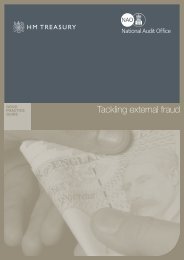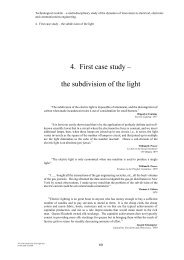Valuation Techniques for Social Cost-Benefit Analysis: - HM Treasury
Valuation Techniques for Social Cost-Benefit Analysis: - HM Treasury
Valuation Techniques for Social Cost-Benefit Analysis: - HM Treasury
Create successful ePaper yourself
Turn your PDF publications into a flip-book with our unique Google optimized e-Paper software.
34<br />
See Blumenschein et al. (2008) <strong>for</strong> a review of the methods developed to tackle hypothetical<br />
bias in contingent valuation.<br />
ii) Protest valuations<br />
Respondents with a positive true WTP may put <strong>for</strong>ward a zero stated valuation due to, <strong>for</strong><br />
example, ethical objections to the idea of paying <strong>for</strong> the good under consideration. If such<br />
respondents are not identified through follow up questions, and their responses consequently<br />
excluded from the statistical analysis, then biased estimates of the value of the good will result.<br />
Hanley and Shrogen (2005) suggest that protest values can be reduced by making WTA<br />
scenarios more acceptable by specifiying community-level compensation rather than individual<br />
compensation ―if individuals are adverse to the idea of benefiting personally in money terms‖<br />
(p.16).<br />
iii) WTP-WTA disparity<br />
All stated preference survey choices and questions can be presented in terms of WTP (to receive<br />
a good or prevent a loss) or in terms of WTA (to lose a good or incur a loss). In theory, WTA <strong>for</strong><br />
most goods evaluated under Stated Preferences should exceed WTP by a few percentage points<br />
due to the fact that WTP is constrained by an individual‘s income (Sugden, 2005). Numerous<br />
papers have found, however, that stated WTP is often far below stated WTA <strong>for</strong> the same good<br />
(Shogren et al, 1994; Horowitz and McConnell, 2002). Sugden (2005) argues that the most<br />
credible explanations <strong>for</strong> this relate to the psychological arguments concerning loss aversion and<br />
its derivative; the endowment effect (Kahneman and Tversky, 1979; Loewenstein and Adler,<br />
1995; Ariely, 2009).<br />
Some authors argue that the appropriate <strong>for</strong>mation depends on property rights (Carson et al,<br />
2001). That is, if the respondent does not currently have the good and does not have a legal<br />
entitlement to it, the WTP <strong>for</strong>mation should be used. On the other hand, if the consumer is<br />
being asked to give up a legal entitlement, the WTA <strong>for</strong>mation is appropriate (Carson, 2000).<br />
Following this approach means there<strong>for</strong>e that legal property rights can have a substantial<br />
influence on the estimated welfare effects of interventions.<br />
Other authors have argued that the WTP <strong>for</strong>mulation should always be used (Arrow et al.,<br />
1993). One reason <strong>for</strong> this is that CV studies adopting a WTA <strong>for</strong>mulation have often been<br />
unsuccessful due to an inability to convince respondents that they have the right to sell a nonmarket<br />
good (Mitchell and Carson, 1989). The WTP-WTA disparity may also be, to some extent,<br />
a product of in<strong>for</strong>mational constraints and inexperience. Bateman et al.‘s (2009) virtual reality<br />
survey tool described above reduced the difference between WTP and WTA <strong>for</strong> environmental<br />
goods. List (2003) finds that experienced traders (in a number of different real markets) do not<br />
exhibit the endowment effect. The WTP-WTA disparity may be reduced by re-calibrating WTP<br />
values into WTA amounts (List and Shrogen, 2002).<br />
iv) <strong>Cost</strong>ly<br />
Stated preference studies can be both financially costly and time-consuming. They require focus<br />
group and interviews to determine respondents‘ understanding, and pre-tests (Carson 2000;<br />
Mitchell and Carson, 1989; Bateman et al, 2002). DTLR (2002), although noting that it is<br />
difficult to generalise, state that, ―it is unlikely that reliable research <strong>for</strong> a single sample study can<br />
be carried out <strong>for</strong> less than £25-£30,000 (excluding the field survey costs)‖.<br />
v) Survey-related biases





![AIRTO [Professor Dr Brian Blunden] - HM Treasury](https://img.yumpu.com/15492848/1/184x260/airto-professor-dr-brian-blunden-hm-treasury.jpg?quality=85)










